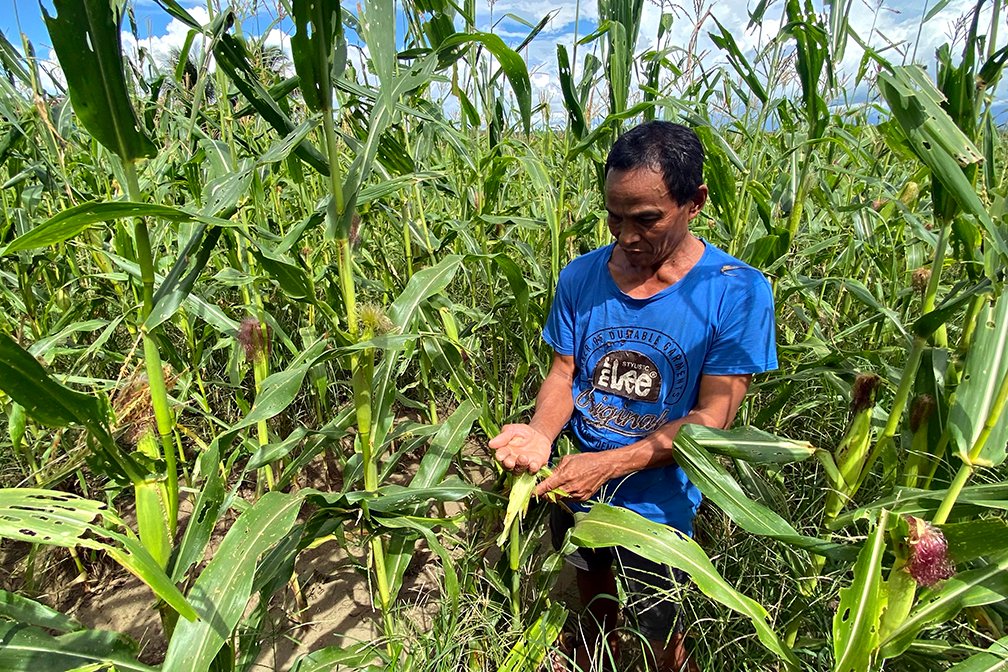BUTUAN CITY—While still recovering after the massive damage to their agriculture area from the flood waters that submerged their farmland in February this year, Mario Cabahug, 66, fears that the worst is yet to come as the intense heat combined with the emergence of an invasive worm species sinks further their hopes of recovery.
Cabahug, a farmer since he was a boy, expressed his helplessness as he faced the rising crisis on his small farm in Purok 8, Barangay Nato, in the town of Esperanza, Agusan del Sur province.
“I’ve never experienced anything like this in my entire life, I’ve hoped that after the massive flood that swept this land, I could recover from whatever I’ve lost; but just as the flood waters receded from the constant heavy rains, almost immediately the intense heat killed what little portion of vegetables I’ve planted, and the only hope I had was on the corn, but now they are also dying,” said Cabahug.
hundreds of infested corn plants.
Based on the May 27 damage assessment report from the Agusan del Sur Provincial Agriculture and Veterinary Office, the towns of Bunawan, Esperanza, Loreto, Trento, Lapaz, Santa Josefa, Talacogon, San Luis and Bayugan City reported that planted corn mostly in the vegetative stage had been infested by the Fall armyworm (Spodoptera frugiperda), a voracious invasive species from eastern and central North and South America that first appeared in the province of Cagayan in 2019.

With a voracious appetite, the Fall armyworm, better known as FAW, is the larval stage of a Grey-brown moth, an adult moth that is usually 1-1⁄4 to 1-1⁄2 inches from wing tip to wing tip, with a brown or gray forewing, and a white hindwing.
“The reports from the field started coming in March. We then dispatched our teams to verify the situation as…initially only the towns of Esperanza and Loreto were affected. By April the FAW had already spread to more towns affecting several barangays. Most of the affected corn are in their vegetative stage,” said Armando G. Valiente, provincial agriculturist of Agusan del Sur.
Valiente said this is the first time the province experienced such kind of pest infestation of corn crops, affecting around 2,427 farmers with a total land area of 3,963 hectares—with a total value of the damage at P56,451,692, a sum that is feared to rise as the area affected is still growing.
The town of La Paz reported the largest area damaged among all the municipalities with 1,435.10 hectares affecting 12 barangays with a value of 24,330,350.70.

Climate-linked infestation
Cabahug said he had experienced the drought that affected their farm in 1983 for several months, but even if this year’s heat from the El Niño phenomenon had only been two months, the battle is so much different.
“Unlike the dry hot months in the drought of 1983, this year we have to worry about the worms that have infested our corn crops before it might be hot, and it might hinder productivity, but at least there are still crops that will survive. Now you have two problems, the intense heat and then the worms that will eat away the money we have borrowed to plant this season,” said Cabahug.
“We are fighting two fronts, two enemies, it’s a losing battle,” Cabahug added. “The damage is massive: usually in a hectare we will harvest 120 sacks of corn but now I doubt that…even 50 percent can be harvested. Our corn is still growing, yet amid all our efforts like spraying pesticides, and even using different brands just to find something that will be effective, the worms continue to wreak havoc on our crops.”
While field validation is still being done, preliminary data from the Regional Crop Protection Center (RCPC) of the Department of Agriculture Caraga Region showed a total of 770 farmers were affected by the FAW infestation that damaged around 1,378.65 hectares of agricultural land area in Agusan del Sur, Agusan del Norte, Butuan City and a small area in the municipality of Cagdianao in the Dinagat Island province.
Ana Marie Plaza, Officer-in-Charge, RCPC of DA Caraga, said they monitored the FAW in the region in 2020. Still, this cropping season’s infestation is unprecedented compared to previous years.
“In 2020, during the height of the pandemic, we started monitoring the presence of FAW in our corn crops in Caraga. From 2021 until 2023, the number of infected corn plants has been very minimal that it did not even show that much dent on our farmers’ yield. But we’re surprised it spiked beyond our expectations in this year’s cropping,” said Plaza.
In Plaza’s view, the sudden rise in FAW infestation in Agusan del Sur might have something to do with the abrupt change in the weather pattern with the onset of warmer temperatures which increased from March to May.
“We’ve noticed that most of the infected farms and the towns affected by the FAW this year are those same areas that were flooding back in February, so from the straight two months of rain and flood, after it ended, by mid-March we had the rise in temperature and the intense heat resulting in a dry spell by March. These are favorable conditions for the worm to multiply and infect more farms,” said Plaza.
Plaza said the pupae of the FAW might have stayed under the soil affected by the flooding, and emerged after the waters receded. The hot summer weather favored their faster development.
Several published scientific studies on the FAW—the most recent in March 2023 entitled, “Climate Change Can Trigger Fall Armyworm Outbreaks: A Developmental Response Experiment With Two Mexican Maize Landraces,” pointed to the faster development of Spodoptera frugiperda when the weather is warm.
In a February 2022 study from China, “The Effect of Temperatures and Hosts on the Life Cycle of Spodoptera frugiperda (Lepidoptera: Noctuidae),” the research team reported that when temperatures rose, the developmental period of FAW at each stage shortened significantly, with instar larvae developing rapidly on maize at 25°C and 30°C, while feeding on maize at 30°C resulted in a lower mortality rate, a shorter developmental time and longevity, and a higher ability to produce an abundance of offspring compared to lower temperatures.
Resistant to commercial pesticides
THE assessment report made by the Agusan del Sur Provincial Agriculture and Veterinarian Office indicated that most farmers sprayed insecticide more than five times, but the FAW infestation persisted.
Farmer Robin Nowhere, 61, from Purok 5, Barangay San Nicolas in the town of Talacogon, expressed his disbelief amid the efforts they’ve made in spraying pesticides; the worms doubled in numbers.
“Although I only have a small land where I planted corn, our expense from plowing and preparing the land, the seedlings, planting, and fertilizers has increased because of how much we have paid for in spraying of pesticides. We’ve already used different types just to make it work, but they just keep on producing more and it has devastated the middle part of the farm,” said Nowhere.
Nowhere added that, “This is the first time in our entire life that we’ve seen this kind of infestation on our crops. Last February, I lost more than P10,000 after the flood waters swept through our farm. We hoped that this cropping season we could recover from that loss and also pay some of our debts, but I never expected this kind of problem. This time I estimate our loss to be nearly P20,000 because of the expensive pesticides.”
Plaza warns farmers against experimenting and mixing different cocktails of pesticides as this causes more problems without eliminating the worms and further enhancing their survivability.
“We’ve received reports that out of desperation, some farmers are mixing different types of pesticides and increasing the amount sprayed into the infested crops. The problem with this is that it will not be effective and it will have an opposite result as it will only enhance their immunity against the pesticides,” said Plaza.
To make the pesticides work, Plaza said, the farmers should individually open the portion where the worms are located in each plant and direct the nozzle of the sprayer on the affected stalk.
Natural solutions
Plaza revealed that while farmers are trying to experiment with what type of pesticides should they spray, their team is working on using an environmentally friendly, all-natural safer solution to the pest problem.
The RSPC conducted a series of information campaigns to help educate farmers on how to better fight the infestation using biological control agents (BCA).
Plaza enumerated the BCAs they are advising farmers to use: “Our farmers can use the Fall armyworm lure; this is a pheromone-based solution, this will attract the male moths and catch them, we usually hang 40 lure traps per hectare.”
“We also have Trichogramma evanescens, a small parasitic wasp, an egg parasitoid which means it needs a host to survive; in this case, it will use the moth’s eggs to live by consuming it from within. We recommend 100 Tricho per hectare,” she said.
Another alternative pesticide suggested by RSPC is by using Metarhizium anisopliae, a pathogenic fungus that infects the insect larvae, attaching itself and infecting the FAW.
Then there is the Nuclear Polyhedrosis Virus (NPV), a viral disease that attacks the FAW after the larvae have eaten the NPV particles infecting the gut cell, and spreading to the blood within 24 hours killing the host larvae.
Plaza explained that while BCA solutions are available, the massive infestation has caught them off guard, resulting in a limited supply that not everyone can access immediately.
While the onset of the rainy season has already started, Caraga Region still experiences warm temperatures, and authorities are concerned that the FAW infestation will continue to spread and infect more areas throughout the region.
Meanwhile, despair is rising, and hunger looms.
Image credits: ERWIN M. MASCARIÑAS










